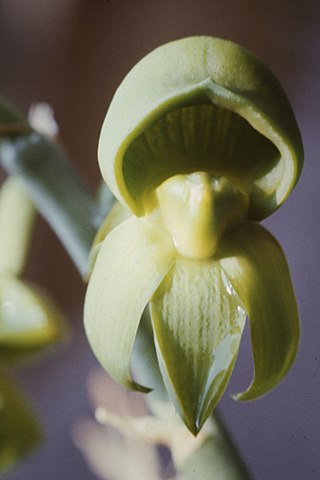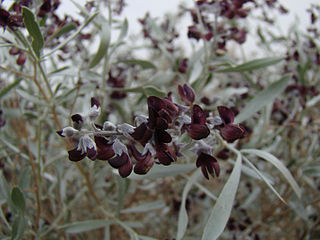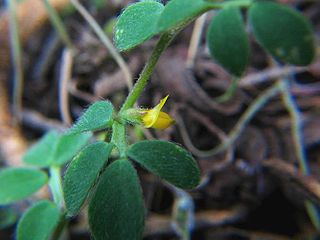
Lotus, a latinization of Greek lōtos, is a genus of flowering plants that includes most bird's-foot trefoils and deervetches. Depending on the taxonomic authority, roughly between 70 and 150 species are accepted, all legumes; American species formerly placed in the genus have been transferred to other genera. Lotus species are found in the Eastern Hemisphere and adapted to a wide range of habitats.

Valeriana is a genus of flowering plants in the family Caprifoliaceae, members of which may be commonly known as valerians. It contains many species, including the garden valerian, Valeriana officinalis. Valeriana has centers of diversity in Eurasia and South America, and is represented by native species on all continents except Antarctica.

Lotus tenuis is a flowering plant of the pea family Fabaceae, native to western and southern Europe and southwest Asia. Some botanists treat it as a subspecies of Lotus corniculatus, as L. corniculatus subsp. tenuifolius.

Tipularia discolor, the crippled cranefly or crane-fly orchid, is a perennial terrestrial woodland orchid, a member of the family Orchidaceae. It is the only species of the genus Tipularia found in North America. It occurs in the southeastern United States from Texas to Florida, the range extending north into the Ohio Valley and along the Appalachians as far north as the Catskills. There are also isolated populations in Massachusetts and in the Great Lakes region. Tipularia discolor is a common early pioneer during secondary succession, readily colonizing woodland habitats during early developmental or regrowth stages.

Catasetum discolor, the differently colored catasetum, is a species of orchid.

Ammodendron is a genus of flowering plants, called the sand acacias, in the family Fabaceae. It contains five species, which range from Iran through Central Asia to Xinjiang. It belongs to the subfamily Faboideae. Its name is derived from the Greek άμμοςammos ("sand") and δένδρονdendron ("tree").

Acmispon dendroideus, synonym Syrmatium veatchii, is a species of legume native to California. It is known by the common name island broom. It is endemic to the Channel Islands of California, where it grows on coastal bluffs and cliffs. It is a spreading perennial herb or erect shrub approaching 2 meters in height. It is hairless to hairy and gray-green in color. The branches lined with leaves each made up of a few oval leaflike leaflets up to 1.5 centimeters long each. The inflorescence bears up to 10 yellow pealike flowers, each roughly a centimeter long and fading red as they age.

Acmispon wrangelianus is a species of legume native to California and Oregon in the southwestern United States. It is known by the common names Chilean bird's-foot trefoil and Chile lotus. Despite its common name, it is not from Chile. It can be found in many types of habitat, including disturbed areas. This is a hairy, prostrate annual herb. Its slender branches are lined with leaves each made of generally four small leaflets. The inflorescence is composed of a solitary yellow pealike flower around a centimeter wide. The fruit is a legume pod one to two centimeters long.
Listia is a genus of flowering plants in the family Fabaceae and the tribe Crotalarieae. Members of this genus are mainly found in southern Africa but some species can be found in central Africa. It was recently segregated from the genus Lotononis. Unlike other members of the Crotalarieae, members of the genus Listia have lupinoid root nodules.
Acmispon tomentosus is a perennial plant in the family Fabaceae in the genus Acmispon. It is native to California and northwestern Mexico. The variety A. tomentosus var. glabriusculus has the synonym Acmispon heermannii.
Lotus argyrodes is a plant species in the genus Lotus endemic to the Azores and Madeira Islands.
Lotus emeroides is a species of plant in the Lotus genus endemic to the Canary Islands.
Lotus eriophthalmus is a plant in the genus Lotus endemic to the Canary Islands.
Lotus frondosus is a perennial plant from the Lotus genus ranging from E. Ukraine to Caucasus and Mongolia.

Lotus germanicus is a species of plant in the genus Lotus native to Central and Southeastern Europe.
Lotus goetzei is a plant in the genus Lotus ranging from Ethiopia to S.southern Tropical Africa.
Lotus hebecarpus is an annual to perennial plant in the genus Lotus ranging from NE Sudan to Djibouti.
Lotus hebranicus is a rare shrubby plant in the genus Lotus ranging Sinai to Eritrea.

Lotus holosericeus or silvery heartwort is a plant in the genus Lotus endemic to the Canary Islands.
Lotus lebrunii is species in the genus Lotus endemic to the DR Congo.










